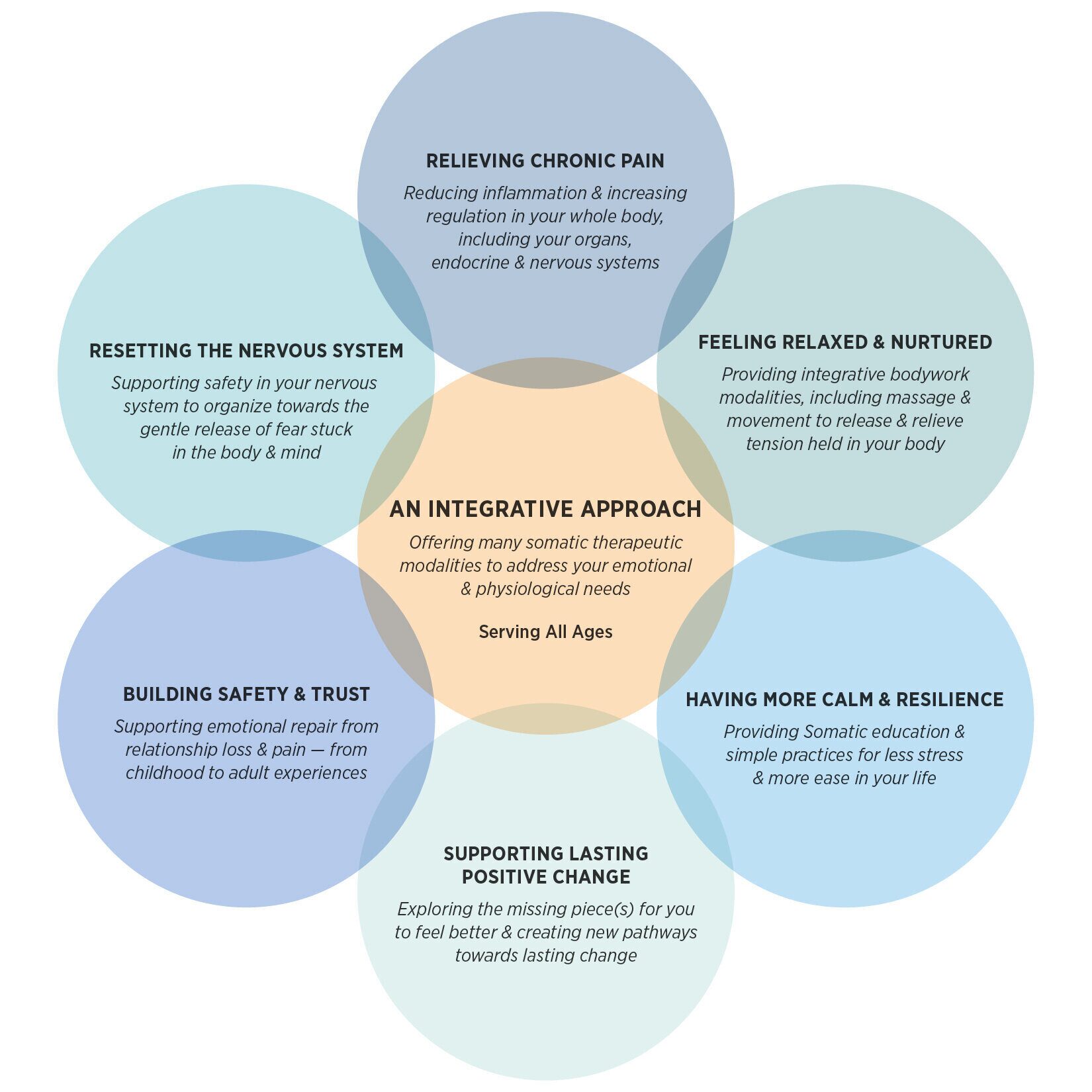
Somatic Therapy for your Body and Mind: Have you ever felt a knot of anxiety tightening your chest during a stressful presentation? Or maybe a dull ache settles in your lower back after a long day of sitting at your desk? These physical sensations are often more than just aches and pains – they can be your body’s way of communicating with you. Somatic therapy delves into this mind-body connection, helping you understand how your physical experiences are linked to your emotional state.
Unlike traditional talk therapy that focuses primarily on thoughts and emotions, somatic therapy takes a holistic approach. Imagine your mind and body as two sides of the same coin – constantly influencing each other. Somatic therapists believe that unresolved emotional experiences can be stored in the body as tension, discomfort, or even illness. Through a variety of techniques, somatic therapy helps you access these embodied experiences, release the associated emotional baggage, and ultimately, achieve greater emotional and physical well-being.
Core Concepts of Somatic Therapy

1. The Mind-Body Connection
Somatic therapy is built on the fundamental principle that the mind and body are intricately linked. Our thoughts, emotions, and experiences are not just mental constructs – they have a physical impact on us as well. Stress, for example, can manifest as muscle tension, headaches, or digestive issues. Conversely, physical discomfort can negatively impact our mood and energy levels. Imagine a complex web, where changes in one thread inevitably affect the entire structure – that’s the mind-body connection in a nutshell.
2. The Body Keeps the Score
According to somatic therapy principles, unresolved emotional experiences, like trauma or chronic stress, can leave their mark on the body. These experiences can be stored as tension patterns, restricted breathing, or even chronic pain. By ignoring these physical signals, we may be unknowingly holding onto emotional baggage that continues to impact our well-being. Imagine a filing cabinet overflowing with unprocessed emotions – somatic therapy helps you sort through these files, understand their contents, and finally let go.
3. The Power of Awareness
A core aspect of somatic therapy is developing greater awareness of your body’s sensations. This can involve noticing subtle shifts in your posture, identifying areas of tension, or paying attention to your breath. By attuning to these physical signals, you can begin to understand how your body is responding to your emotions. Think of yourself as a detective, gathering clues from your body to solve the mystery of your emotional state.
Exploring the Techniques

Somatic therapy utilizes a variety of techniques to help you access and release embodied emotions. Here are a few common approaches:
1. Body Mapping
This technique involves creating a map of your body, highlighting areas of tension or discomfort. By focusing on these areas, you can explore the emotions and memories associated with them. Imagine yourself as a cartographer, charting the emotional landscape of your body.
2. Breathwork
Breath is a vital link between the mind and body. Somatic therapists may use breathwork exercises to help you regulate your nervous system, promote relaxation, and access deeper emotional states. Think of your breath as a bridge, connecting your conscious mind to the deeper well of your emotions.
3. Movement Techniques
Movement plays a crucial role in somatic therapy. Techniques like gentle yoga poses, guided movement exercises, or mindful dance can help release physical tension and express emotions in a safe and supportive environment. Imagine your body as a locked door – movement can help turn the key and unlock the emotional energy trapped within.
Who Can Benefit from Somatic Therapy?
Somatic therapy can be beneficial for a wide range of individuals. Here are some examples:
- People struggling with anxiety, depression, or chronic stress
- Individuals who have experienced trauma or emotional abuse
- Those seeking to manage chronic pain or physical discomfort
- Anyone interested in developing greater mind-body awareness and emotional well-being
Taking the First Step: Embarking on Your Somatic Journey

If you’re curious about somatic therapy, here’s how to get started:
- Do some research: Learn more about somatic therapy and find a qualified practitioner in your area. Look for therapists trained in modalities such as Hakomi Therapy, Sensorimotor Psychotherapy, or Integrative Body Psychotherapy.
- Schedule a consultation: Discuss your goals and expectations with the therapist to see if somatic therapy is a good fit for you.
- Be open to the process: Somatic therapy can be an enlightening and transformative experience, but it may also bring up challenging emotions. Be patient with yourself and trust the process.
Beyond the Therapy Room: Integrating Somatic Practices into Daily Life
The benefits of somatic therapy extend beyond the therapy room. Here are some ways to integrate somatic practices into your daily life:
- Mindful movement: Take some time each day to simply move your body and become aware of your sensations. This could be a short walk in nature, some gentle stretches, or even dancing to your favorite music.
- Body scan meditation: Lie down comfortably and focus on different parts of your body, noticing any areas of tension or discomfort. Allow yourself to simply observe these sensations without judgment.
- Deep breathing exercises: Take a few minutes throughout the day to practice deep, diaphragmatic breathing. This can help to calm your nervous system and promote relaxation.
- Paying attention to your body’s signals: Throughout the day, check in with your body. Are you holding your breath? Do you have a knot in your shoulders? Notice these signals and try to understand what they might be telling you.
Conclusion
Somatic therapy offers a unique approach to healing and well-being. By acknowledging the mind-body connection and developing greater awareness of your physical sensations, you can begin to understand and release emotional baggage that may be holding you back. Somatic therapy is not a quick fix, but rather a transformative journey of self-discovery and healing. Are you ready to listen to the wisdom of your body and embark on this journey?
You May Also Like….
- Confidence: How to Trick Your Mind Into Feeling Confident
- The Unexpected Benefits of Crying
- Weirdest Inventions Ever Made: You would never believe they exist!!!!
FAQs
Q1: Does somatic therapy replace traditional talk therapy?
Somatic therapy can be a powerful complement to traditional talk therapy. While talk therapy focuses on processing thoughts and emotions, somatic therapy focuses on the physical manifestations of those emotions.
Q2: Is somatic therapy right for everyone?
Somatic therapy can be beneficial for a wide range of individuals, but it may not be for everyone. If you have experienced significant trauma, it’s important to find a therapist who is experienced in working with trauma survivors.
Q3: What are some potential risks associated with somatic therapy?
Somatic therapy can sometimes bring up challenging emotions. It’s important to work with a qualified therapist who can create a safe and supportive environment for you to explore these emotions.
Q4: How long does somatic therapy typically last?
The length of somatic therapy can vary depending on your individual needs and goals. Some people may benefit from short-term therapy, while others may choose to continue for a longer period.
Q5: How can I find a qualified somatic therapist?
There are several resources available to help you find a qualified somatic therapist. You can search online directories for therapists trained in somatic modalities or ask your doctor for a referral.


